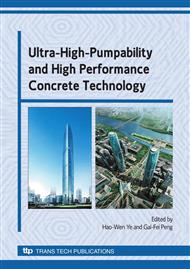p.212
p.219
p.226
p.234
p.242
p.249
p.256
p.262
p.267
Early-Age Heat Evolution and Pore Structure of Portland Cement Blended with Blast Furnace Slag, Fly Ash or Limestone Powder
Abstract:
Recently, blast furnace slag, fly ash and limestone powder are increasingly used as blending materials in producing concrete. The use of these materials not only has economical and environmental advantages, but also improves the mechanical properties, durability and workability of concrete. In this paper, the results of experimental investigations on the evolution of hydration heat and the development of microstructure of Portland cement blended with blast furnace slag, fly ash or limestone powder are presented. These results show that three blending materials accelerate the hydration of Portland cement, but result in less heat release during the first 72 hours. The Portland cement with blast furnace slag has a denser pore structure than the others.
Info:
Periodical:
Pages:
242-246
Citation:
Online since:
January 2009
Authors:
Price:
Сopyright:
© 2009 Trans Tech Publications Ltd. All Rights Reserved
Share:
Citation:


